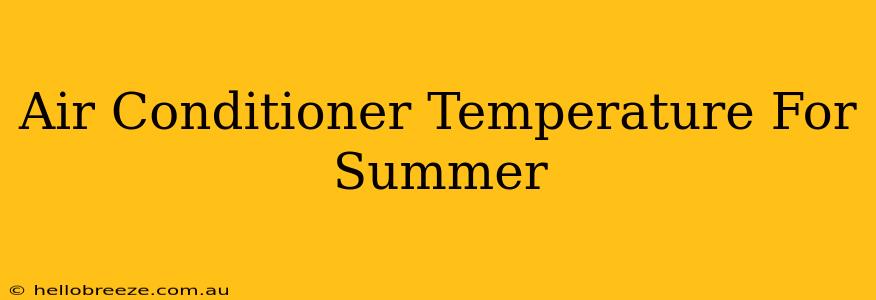Summer heat can be brutal. Finding the perfect air conditioner temperature is a balancing act between staying comfortable and keeping your energy bills manageable. This guide will help you determine the ideal temperature setting for your AC unit this summer, along with tips for maximizing energy efficiency and minimizing your environmental impact.
The Ideal AC Temperature for Summer
There's no single "perfect" temperature, as individual preferences and health conditions play a significant role. However, most experts recommend setting your thermostat between 72°F and 78°F (22°C and 26°C). This range balances comfort with energy efficiency.
Why 72-78°F?
- Comfort: While some may prefer cooler temperatures, the human body can comfortably adjust to temperatures within this range, especially if you adopt some of the additional tips below.
- Energy Savings: For every degree you raise the thermostat, you can save around 1-3% on your cooling costs. Raising the temperature by even a few degrees can significantly impact your energy bill over the summer months.
- Health Benefits: Slightly warmer temperatures can help improve sleep quality and reduce the risk of health problems associated with excessively cold environments.
Factors Affecting Your Ideal Temperature
Several factors can influence the ideal AC temperature setting for your home:
1. Personal Preference:
Your personal comfort level is paramount. Experiment to find the temperature that feels most comfortable to you while staying within the recommended energy-efficient range.
2. Health Conditions:
Individuals with certain health conditions, such as heart conditions or respiratory problems, may require slightly warmer or cooler temperatures for optimal comfort and health. Consult your doctor if you have concerns.
3. Activity Levels:
If you spend most of your day at home, a slightly higher temperature might suffice. However, if you're very active, you might prefer a cooler temperature.
4. Type of Home:
Well-insulated homes may require less cooling than older homes with poor insulation. Proper insulation and sealing can significantly reduce energy usage.
5. Occupancy:
When no one's home, consider raising the thermostat to conserve energy. Programmable thermostats offer convenient automated adjustments.
Boosting Efficiency Beyond Temperature Setting
Setting your thermostat to the right temperature is just one piece of the puzzle. Here's how to maximize energy savings and comfort:
1. Regular Maintenance:
Regular AC maintenance, including cleaning or replacing air filters, ensures your unit runs efficiently and effectively. A clogged filter can significantly reduce cooling capacity and increase energy consumption.
2. Proper Insulation:
Ensure your home is properly insulated to prevent heat from entering during the summer. This reduces the strain on your AC unit and saves energy.
3. Window Treatments:
Utilize curtains, blinds, or shades to block out direct sunlight during the hottest parts of the day. This reduces the amount of heat entering your home and keeps it naturally cooler.
4. Energy-Efficient Appliances:
Consider upgrading to energy-efficient appliances, including refrigerators and other heat-producing devices. These contribute less heat to your home.
5. Ceiling Fans:
Ceiling fans can improve airflow and create a more comfortable environment, allowing you to raise the thermostat slightly without sacrificing comfort.
Finding the Perfect Balance
Finding the right air conditioner temperature for summer involves balancing personal comfort, energy efficiency, and health. Start with the recommended range of 72°F to 78°F (22°C to 26°C), experiment to find your ideal setting, and remember that optimizing your home's energy efficiency complements your thermostat setting. By using these tips you can stay comfortable all summer long while keeping your energy bills and carbon footprint in check!

